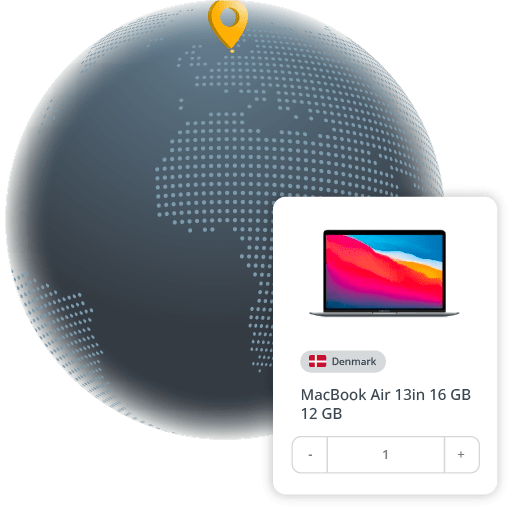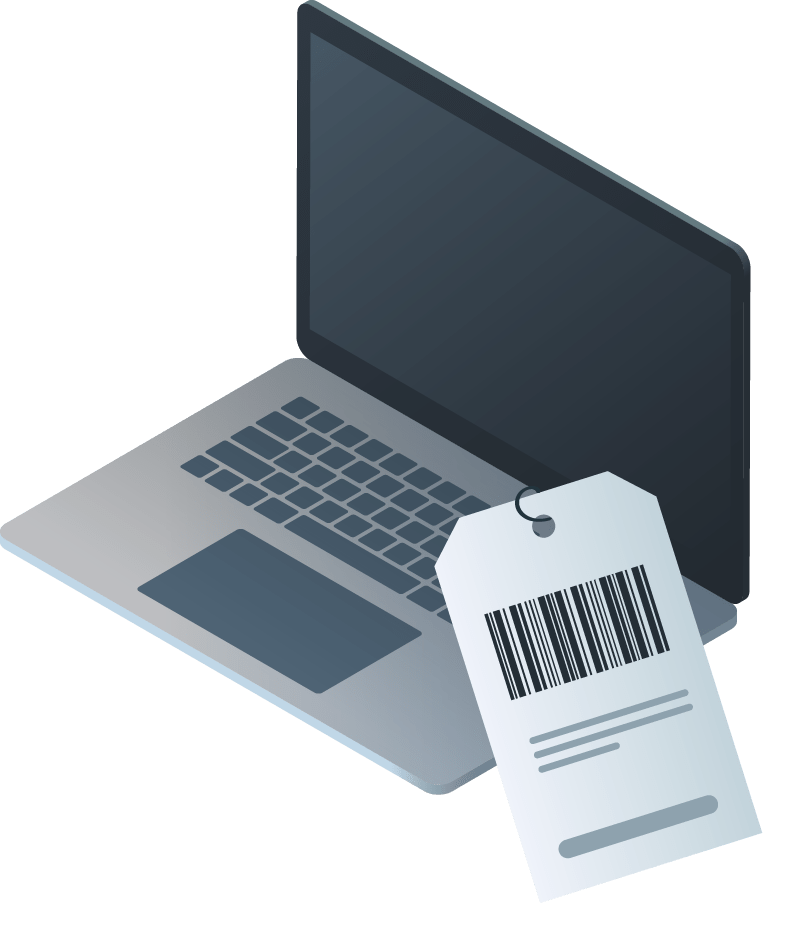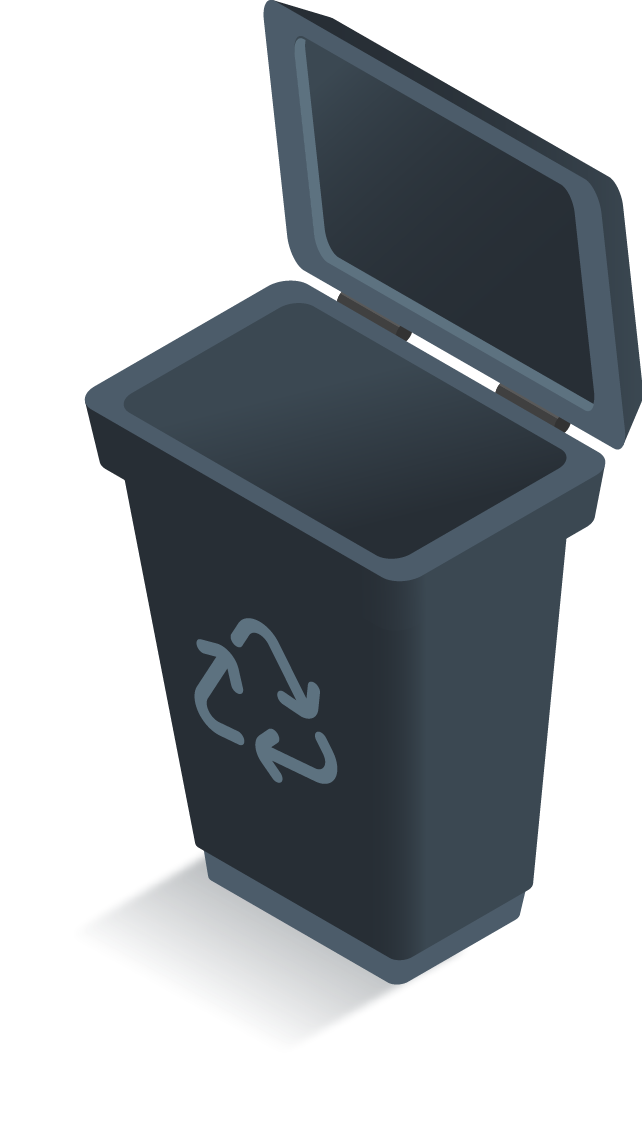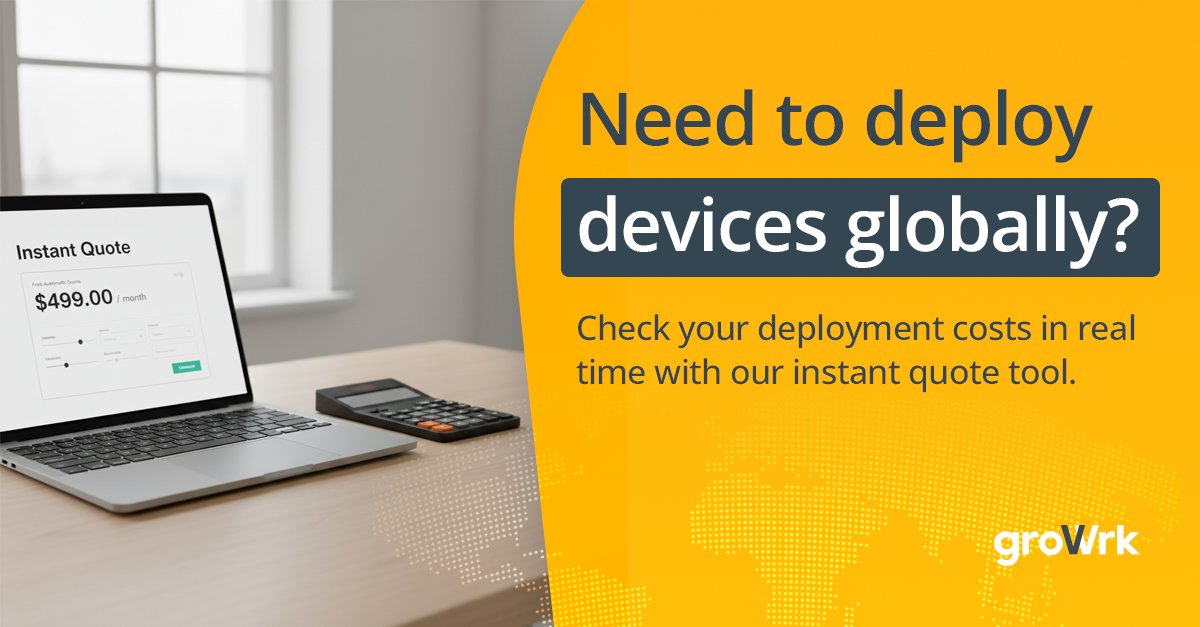How to send IT equipment to Denmark
Are you planning to send IT equipment to remote teams in Denmark? GroWrk specializes in streamlining your IT asset management across borders, making it easier to get your laptops, servers, or other essential devices to Denmark without stress. From handling logistics to managing customs and ensuring compliance with local regulations, we take care of it all.

At a glance
Denmark’s IT operations are highly efficient, driven by strong digital infrastructure and widespread cloud adoption. The country leads in sustainable IT, prioritizing green technologies and energy-efficient data management. A skilled workforce, emphasis on IT education, and favorable regulations make Denmark a prime hub for tech startups and global enterprises.
|
CURRENCY Danish Krone (DKK) |
OFFICIAL LANGUAGE Danish |
TIME ZONE Central European Time (CET) GMT+01:00 (Central European Summer Time (CEST) GMT+02:00 during daylight saving time) |
|
CUSTOMS DUTY ON ELECTRONICS 0-5% + 25% VAT Typically 0-5% customs duties and 25% VAT, with possible reductions or exemptions for certain categories of goods |
SHIPPING LEAD TIME 3-7 days (depending on location and shipping method) |
IT OUTSOURCING MARKET €9.1 billion €7.4 billion in 2024, expected to grow significantly, with projections indicating it will reach €9.1 billion by 2025 |
Overview of IT operations in Denmark

Digital Innovation Leader: The European Commission recognizes Denmark as one of the EU's most digital economy and society, with 94% of citizens actively using online services. They focus on innovation across industries like fintech, e-commerce, and tech startups. The government actively supports digital transformation initiatives to improve both public services and business operations.
Advanced IT Infrastructure: Denmark has a robust and reliable IT infrastructure, with high-speed internet access and a dense network of data centers. This makes it a prime location for cloud computing, hosting services, and international businesses looking to expand their digital operations.
Sustainability Focus: Known for its commitment to environmental sustainability, Denmark leads in green IT practices. Many data centers in the country operate on renewable energy, and there is a strong push towards energy-efficient technologies in the IT sector.
Skilled Workforce: Denmark’s education system emphasizes tech and digital skills, creating a highly skilled workforce. The country is home to a large pool of IT professionals proficient in coding, software development, cybersecurity, and system administration.
Business-Friendly Environment: With a transparent regulatory environment, favorable tax policies, and strong data protection laws, Denmark is an attractive destination for tech companies looking to establish a presence in Europe. Its pro-business approach encourages foreign investment and collaboration.
Strong Cybersecurity Framework: Denmark has one of the most well-developed cybersecurity strategies in Europe, with stringent laws and initiatives to safeguard digital systems, critical infrastructure, and user data.
Tech Ecosystem and Startups: Denmark boasts a thriving startup ecosystem, particularly in cities like Copenhagen, which serves as a hub for tech innovation and venture capital. The government offers various incentives to support startup growth, including funding and networking opportunities.
Shipping IT equipment to Denmark: What you need to know
| Customs regulations |
|
| Duties and taxes |
|
| Required documentation |
|
| Import restrictions |
|
| New vs. Used equipment |
|
| Sensitive Technology |
Certain types of IT equipment, such as encryption software, military-grade technology, and surveillance equipment, may require special permits or export licenses. These items are subject to strict export control regulations within the EU. Before shipping, ensure that you have the necessary approvals from the Danish authorities, such as the Danish Business Authority (Erhvervsstyrelsen), or from the EU’s dual-use export control regulations. |
| Penalties or fines for non-compliance |
|
Checklist for sending laptops to Denmark
When shipping laptops to Denmark, it’s important to follow a few best practices to ensure the process goes smoothly, and your equipment arrives safely and on time. Here are some helpful shipping tips:

Select trusted couriers: Choose reliable couriers such as GroWrk, DHL, UPS, FedEx, or PostNord for international shipping. These carriers offer tracking services and have experience handling Danish customs procedures.
Check service levels: Select the appropriate shipping option based on urgency. Express shipping (2-5 days) for high-priority deliveries. Standard shipping (5-10 days) for cost-effective options.
Use high-quality packaging: Secure laptops with sturdy, padded boxes and protective materials like bubble wrap, foam inserts, or air cushions to prevent damage during transit.
Disassemble where possible: If shipping accessories like chargers, docking stations, or monitors, package them separately to prevent damage. Remove detachable components if applicable.
Label clearly: Ensure the recipient’s name, address, and contact details are correctly labeled. Mark the package as "fragile" to encourage careful handling.
Accurate product descriptions: On the commercial invoice, provide a detailed and accurate description of the laptop, including its brand, model, and serial number. Inaccurate descriptions may cause customs delays.
Value declaration: Declare the correct value of the laptop to avoid under- or over-declaring, which could lead to customs inspections or fines. The declared value determines any applicable duties and taxes.
Customs declarations: Complete and include necessary customs paperwork, such as the EU Single Administrative Document (SAD), Commercial Invoice, and Packing List to ensure smooth clearance.
Proof of origin: If applicable, include a certificate of origin to determine eligibility for preferential trade agreements that may reduce customs duties.
Understand import duties & taxes: Denmark follows EU tariff regulations, meaning laptops are subject to 0% customs duty but must pay 25% VAT on the declared value.
Pre-pay duties and taxes: Some couriers allow for pre-paid duties and taxes to simplify customs clearance and prevent the recipient from facing unexpected charges upon arrival.
Protect against loss or damage: Consider purchasing shipping insurance for high-value laptops to protect against loss, theft, or damage during transit.
Compliance with EU regulations: Ensure compliance with EU electronic safety standards, including CE marking, WEEE (Waste Electrical and Electronic Equipment), and RoHS (Restriction of Hazardous Substances) regulations before shipping.
Use tracking tools: Major couriers provide real-time tracking—monitor shipments closely to anticipate customs clearance updates and delivery progress.
Stay in touch with the recipient: Notify the recipient about the expected delivery timeline, tracking updates, and any customs-related requirements to avoid delays.
Expect weather and seasonal delays: Winter weather and peak shipping periods (e.g., Christmas, Black Friday) may cause delivery delays. Plan shipments accordingly.
Danish domestic delivery options: For final delivery, consider working with PostNord, GLS Denmark, DAO365, or Bring for efficient last-mile distribution.

Average cost of IT Equipment in Denmark
Laptops (Business Grade):
- Mid-range: DKK 5,500 - DKK 11,000
- High-end: DKK 11,000 - DKK 22,000
High-end models such as Apple MacBook Pro, Dell XPS, and Lenovo ThinkPad are priced on the higher end.
Monitors (Business Grade):
- Standard: DKK 1,200 - DKK 2,500
- Ultrawide/4K: DKK 3,500 - DKK 7,500
Monitors from trusted brands like Dell, Samsung, and LG typically range within these prices, with 4K or ultrawide models costing more.
Desktops (Business Grade):
- Standard Desktop PC: DKK 3,000 - DKK 11,000
- Workstation Desktop (for high-performance tasks): DKK 11,000 - DKK 30,000+
Prices depend on the brand and specifications, with options from HP, Lenovo, and Apple among the most common.
Printers (Laser):
- Standard Office Printers: DKK 900 - DKK 2,500
- High-Volume Printers: DKK 4,500 - DKK 15,000
Leading brands such as HP, Canon, and Brother offer a wide range of models for office environments.
Public holidays & IT work hours to plan your shipment
Key public holidays in Denmark:
- New Year’s Day (Nytårsdag) – January 1
- Maundy Thursday (Skærtorsdag) – Thursday before Easter Sunday (date varies)
- Good Friday (Langfredag) – Friday before Easter Sunday (date varies)
- Easter Monday (2. påskedag) – Monday after Easter Sunday (date varies)
- Labour Day (Arbejdernes Internationale Kampdag) – May 1
- Constitution Day (Grundlovsdag) – June 5
- Ascension Day (Kristi Himmelfartsdag) – 40 days after Easter (date varies)
- Whit Monday (2. Pinsedag) – 50 days after Easter (date varies)
- Danish National Day (Danmarks Nationaldag) – June 5 (observed together with Constitution Day)
- Christmas Day (1. juledag) – December 25
- Boxing Day (2. juledag) – December 26
Typical work hours for IT professionals
- Standard Workweek:
The legal workweek in Denmark is typically 37 hours, with employees usually working from 9:00 AM to 4:30 PM, Monday to Friday, with a half-hour to one-hour lunch break.
Many companies, especially in the tech sector, allow for flexible working hours, meaning employees may start and end their workdays at different times to accommodate personal schedules while maintaining the 37-hour workweek. - Overtime:
Overtime is generally limited in Denmark. If overtime is required, it must be compensated, and employees are entitled to additional pay or time off, depending on their contract and company policy.
Overtime work is typically compensated at a higher rate than regular hours, with varying rates depending on the industry and specific company agreements. In many cases, overtime pay is 1.5 times the hourly rate, with certain industries offering even more premium pay for hours worked during holidays or weekends. - Public Holiday Work:
Public holidays such as Christmas and Labour Day may result in office closures or reduced working hours for IT professionals, depending on the company's policies.
Many IT professionals in Denmark may have holiday pay if they work on public holidays, with companies typically offering compensation at higher rates or additional time off.
What to consider when retrieving IT equipment from employees in Denmark
| Local delivery and logistics services |
|
| IT Inventory Management |
|
| Logistics challenges for remote locations |
|
| Equipment agreement with employees |
|
How to dispose of IT equipment in Denmark
Data wiping
- Data wiping: Use certified software to erase data completely from hard drives, SSDs, or other storage devices.
- Shredding and destruction: For higher-security needs, consider physical destruction of storage devices through shredding or other methods to ensure that data cannot be recovered.
Recycling
- Certified e-waste disposal: Companies must use certified e-waste recycling services that are compliant with the WEEE Directive. These services will ensure that your equipment is properly dismantled, with hazardous materials like batteries and mercury being safely disposed of.
- Recycling centers: You can dispose of small electronics by taking them to designated recycling centers or certified e-waste disposal companies. Larger IT assets, such as servers or office-wide equipment, require professional disposal services.
Repurposing IT equipment
- Donation to educational institutions: Many schools or non-profit organizations accept donations of usable IT equipment.
- Internal repurposing: If your organization upgrades equipment regularly, you may repurpose older devices for non-critical tasks or redistribute them within the company.
Manufacturer take-back programs
Many IT equipment manufacturers offer take-back programs that accept old equipment for recycling or repurposing. These programs are a convenient option for businesses and can help ensure that the equipment is disposed of responsibly and complies with Danish regulations.
Certified e-waste recycling providers
Ensure that any third-party service you use for disposal is certified by the Danish Environmental Protection Agency or relevant local authority. They should be able to handle both the recycling and legal documentation required for proper disposal. This includes providing certificates of destruction and confirming that the equipment was disposed of in line with Danish environmental standards.

Local IT Outsourcing Solutions in Denmark
You can streamline your IT logistics and asset management with GroWrk’s comprehensive global solution. Whether it’s shipping equipment or managing IT assets across multiple regions, GroWrk helps you stay compliant and efficient, every step of the way. Here’s why GroWrk is the ideal partner for managing your IT assets in Denmark:

| 1. Wide global coverage |
| With a presence in over 150 countries, including Denmark, GroWrk ensures the smooth deployment of IT equipment to your teams, no matter where they’re based. Our local expertise in Denmark means your team will receive tailored support that aligns with Danish regulations and best practices. |
| 2. End-to-end asset management |
GroWrk simplifies the entire IT asset lifecycle—from procurement and deployment to ongoing management and end-of-life disposal. We take care of all the details so you can focus on driving business growth while keeping your IT operations running smoothly. |
| 3. Intuitive platform for easy deployment |
Our intuitive platform provides a simple, centralized way to manage device deployment, track shipments, and monitor asset usage. This helps reduce administrative overhead, avoid logistical hurdles, and improve efficiency across your IT operations in Denmark. |
| 4. Smooth delivery and equipment retrieval |
GroWrk handles the hassle-free delivery of laptops and IT equipment to your teams across Denmark. We also manage the return of equipment from employees transitioning out of the company, ensuring the entire process is quick, cost-effective, and hassle-free. |
| 5. Compliance with Danish import regulations |
We make sure all shipments comply with Denmark’s import and tax regulations, including relevant customs procedures and product certifications. From import duties to VAT, GroWrk ensures your IT operations meet local standards, avoiding costly delays or compliance issues. |
| 6. Efficient repairs and maintenance |
From routine maintenance to urgent repairs, GroWrk manages all aspects of IT device upkeep, ensuring your equipment stays in peak condition. Our team coordinates repairs, reducing downtime and allowing your employees to stay productive. |
| 7. 24/7 Support for peace of mind |
Our dedicated support team is available around the clock to assist with any questions or concerns about your IT asset management, logistics, or shipping needs. With GroWrk, you can count on expert support whenever you need it. |
Procure, configure, and deploy your IT devices from one platform


